
Treating Sprains and luxations Page Menu: 1 2 3 4 5 6 7 8 9 10 11 12 13 Next>>
Treating Sprains & Dislocations in the Golden Age of Piracy, Page 6
Specific Dislocation/Luxation Cure: Vertebrae
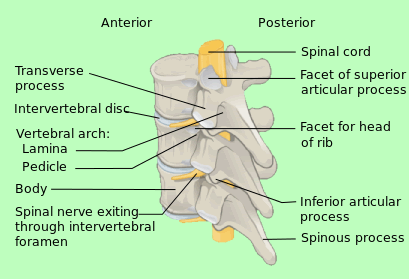
Image: Jordi March - Vertebrae With Parts Labeled
Sea surgeon John Atkins discusses the vertebral column as a unit that can be luxated. However, he puts vertebrae into his class of bones that have 'obscure motion' and are therefore not easily luxated. "What is meant by a luxation of them, I do not well apprehend: ...a Luxation must be ever, I think, of fatal Consequence, as is the Effect of the greatest Strains, and make a Compression of the Spinal-Marrow, whence the Nerves serving to Sense and Motion arise."1 In that, he is not far from wrong. A true luxation of the spine would almost certainly sever the spinal cord and kill the patient.
Nevertheless, Atkins goes on to separate the the spinal column into three distinct parts - the neck, the back and loins - and then discusses the treatment of each. This is similar to the way that Ambroise Paré divides them so this is how we shall discuss them.
1 John Atkins, The Navy Surgeon, 1742, p. 98
Specific Dislocation/Luxation Cure: Vertebrae - Neck
John Atkins and Ambroise Paré agree that perfect dislocations of the neck are unlikely and when they occur are deadly. Atkins says these vertebra "cannot any of them be easily distorted; but the Tendons may be stretched, and is what I imagine is vulgarly called a Broken Neck; removed like the Cramp in a Limb, by pulling the Neck out strait."1 Ambroise Paré explains that unless such a dislocation is quickly treated, it 'brings sudden death" by damaging the spinal marrow and nerves, particularly affecting respiration.
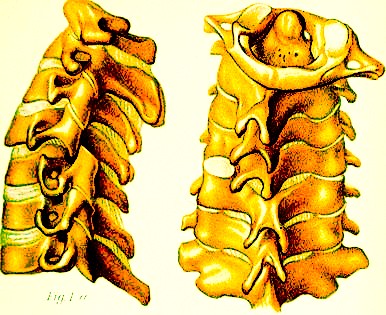
Partially Dislocated Thoracic Region (Neck), From Atlas and Epitome of
Traumatic,
By Heinrich Helferich (1902)
However, Paré also notes that when the luxation is 'incomplete' (a subluxation) it is not necessarily lethal. He says when a thoracic vertebrae are, "a little moved out of their seats, are turned a little to the hind or fore part, then the neck is wrested aside, the face looks black, and there is difficulty of speaking and breathing."2 Atkins mentions the same signs adding that there is distortion of the neck. If the problem isn't quickly dealt with, he states that the patient will have "a Palsy [shaking] of the upper Limbs, Convulsions, and cold Sweats."3
Each author suggests a different method of extension and replacement of the subluxation. Atkins recommends laying the patient flat and having the surgeon place his "Feet at the [patient's] Shoulders, and Hands below the Ears" and then pull.4 Paré recommends sitting the patient on a low seat where he is to "lean and lye with his whole weight upon his shoulders; and the mean while the Surgeon must take the Patients head, about his ears, betwixt his hands, and so shake and move it to every part, untill the vertebræ be restored to its place."5 He explains that restoration of the vertebrae has succeeded when the pain ceases and the patient can turn and move his head 'every way.'
Once the dislocation has been repaired, the patient must lean his head in the direction opposite to the luxation so that his neck can be bandaged, presumably to restrict motion. However "the ligature [must] be not too strait [tight], lest by pressing the weazon [windpipe] and gullet, it straiten [restrict] the passages of breathing and swallowing."6
Atkins cites an interesting, if unsuccessful case study worth mentioning here, if only as an example of the types of situations a sea surgeon sometimes faced. "[O]ne Sculthorp, in her Majesty’s Ship Lion, 1712, being very drunk, fell down the Forescuttle [a hatch in the front of the ship], and fractured (its probably) this [the spinous] Process [the protrusion from the vertebra - see the diagram at top of this page], his Head fell like a dead Lump to either Side, and seemed so loose, that his Face might have been turned almost behind"7. Atkins extended the neck as well as he could and made Sculthorp comfortable, but the patient had difficultly breathing and died about 12 hours later.
1 John Atkins, The Navy Surgeon, 1742, p. 99; 2 Ambroise Paré, The Workes of that Famous Chirurgion Ambrose Parey, 1649, p. 385; 3,4 Atkins, p. 99; 5,6 Paré, p. 385-6; 7 Atkins, p. 99
Specific Dislocation/Luxation Cure: Vertebrae - Back
Sea surgeon John Atkins states that luxations of the spine (above the rib cage), "considering their close Conjunction, and the Ribs being fixed to them, seems impossible; or if they could [be luxated], such a Compression of the Spinal-Marrow must be attended with a fatal Resolution of the Nerves, and Death."1 He does not present a method for curing them.
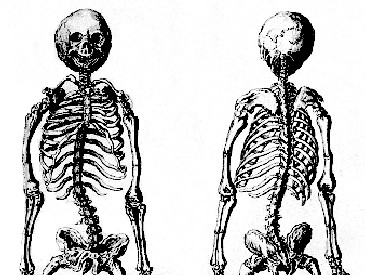
Artist: after George Louis Leclerc Buffon - Skeleton with Rickets (1749)
English military surgeon Richard Wiseman says they are nearly always be caused by inward problems such as the rickets (osteomalacia - weakening of the bones from vitamin D deficiency) and tumors and tells his readers they "require internal Remedies [medicines], so are referrable to a Physician."2 Land-based surgeons like Wiseman were not supposed to prescribe or give medicines to patients; this was the right of the physicians. The only part of such dislocations Wiseman feels the surgeon has to deal with is the application of plasters and bandaging. He admits that back luxations can occur by force, although "[t]he case is so rare, that I think it not needful to add any Discourse here" and refers his readers to other authors.3
Ambroise Paré equally recognizes internal and external causes. He blames the internal luxations on bodily humors or health problems similar to those mentioned by Wiseman. He splits externally-caused dislocations of the back into those pushed inward and those forced outwards. Paré basically dismisses inward luxations as being unlikely "unlesse [caused] by a great deal of violence; and if it at any time happen, it is not but with the breaking of the tyes and ligaments, for they will break rather than suffer so great extension."4 He notes that such a dislocation is deadly.
This leaves outward dislocations of the back, a topic which Paré discusses in some detail. They can be caused by "a fall from high upon some hard body, a heavy and bruising blow, much and often stooping"5. He also notes that they 'bunch forth' in appearance.
Extending and Replacing an Outwardly Dislocated Back
The patient is to lay face down on a table where the surgeon is to "straitly [tightly] to bind him about with towels under the arm-pits, & about the flanks and thighs."6

Fixing an Outwardly Luxated Spine, From The Workes of that Famous Chirurgion
Ambrose
Parey, p. 386 (1649)
The spine is to be extended by pulling the patient from both top and bottom, "yet without violence: for unless such extension be made, restitution is not to be hoped for... Then must you lye with your hands upon the extuberancyes [protruding parts], and force in the prominent vertebræ."7
If this fails, Paré proposes an alternative method using two three to four inch pieces of wood wrapped in linen. "[W]ith your hands to press them against the bunching forth vertebrae, untill you force them back into their seats, just after the manner you see it here delineated [see image at left]."8
He warns his reader not to touch the protruding spinous process (protruding part of the vertebra - see image at the top of the page) because they break easily. He finishes by telling his readers that they will recognize a properly aligned back "by the equall smoothness of the whole Spine."9
Securing the Relocated Spine and Post-Operative Care
Once outwardly luxated vertebrae are restored, Paré tells his readers "to bind up the part, and lay splints or plates of Lead neatly made for that purpose upon it; but so, that they may not press the crists or middle [spinous] processes of the vertebræ, which I formerly mentioned,
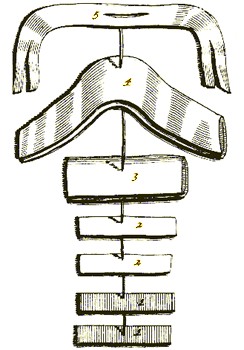
Dressings for Luxated Spine, From A
Description of Bandages and Dressings,
By Charles Gabriel Le Clerc, p. 60 (1701)
but only the sides [of the vertebrae]"10. French surgeon Charles Gabriel Le Clerc gives his usual detailed explanation on bandaging such a dislocation with an accompanying diagram showing the pieces of his dressing. It is in line with Paré's recommendations.
Le Clerc begins by applying the two lead plates which are "to be placed lengthways on the Body of the Vertebra, which is luxated one on each side the Spinal Process, after the Reduction."11 These plates are shown separately in his drawing at the bottom, both being numbered 1. Over these he uses a pair of long linen compresses, folded several times and laid along the spinous processes on top of the lead plates (2). Next he employs another linen compress which has been folded several times. This is labelled 3 and is used to cover everything mentioned including the spine. He then calls for a 'large napkin' (referring to an absorbent rectangular piece of cloth - 4) that is "folded in three Leaves, to embrace the Breast, of which before, this must be pretty strait [tight]."12 Based on his description this is wrapped around the torso with the center being over the first three dressings. The last piece (5) is the scapulary which is used to hold everything in place. He elsewhere describes this as "a Piece of Cloth, about six or seven inches broad, and three quarters of an Ell [about 32 inches] long, with a Cleft in the middle, for putting the head [here probably referring to the spinous process] through"13. The two ends are split, crossed and pinned to the napkin.
Paré advises that once the back is bandaged, "the Patient shall be laid upon his backe in his bed, and the [lead] splints long kept on, lest the vertebræ should fall out again."14
1 John Atkins, The Navy Surgeon, 1742, p. 99; 2,3 Richard Wiseman, Severall Chirurgicall Treatises, 2nd ed., 1686, p. 498; 4,5,6,7 Ambroise Paré, The Workes of that Famous Chirurgion Ambrose Parey, 1649, p. 386; 8,9,10 Paré, p. 387; 11,12 Charles Gabriel Le Clerc, A Description of Bandages and Dressings, p. 61; 13 Le Clerc, p. 56; 14 Paré, p. 387
Specific Dislocation/Luxation Cure: Vertebrae - Lumbar, Sacrum and Coccyx
Sea surgeon John Atkins and French surgeon Ambroise Paré both talk about luxation of the lower part of the spine,
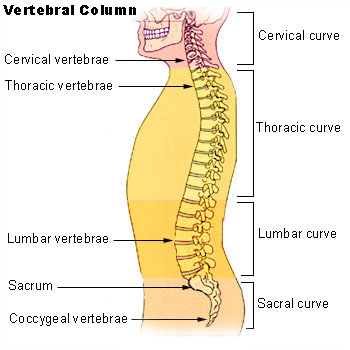
Image: US Government - Vertebral Column Labeled
although they do not seem to be talking about the same parts. Atkins refers to the 'vertebrae of the loins' explaining that they "bow most, and therefore [are] most likely to recede at Manhood [in other words, be dislocated in adults], by violent Strains in Labour or Exercise, and the two or three last of them the likeliest, because the ribs are not fixed to their traverse Processes"1. He is referring to what is today called the lumbar curve of the spine. Paré refers to dislocating 'the rump' which he says is "dislocated inwards by a violent fall upon the buttocks, or a great blow"2. He appears to be referring to the sacral curve containing the sacrum and coccyx.
With regard to the lumbar region, Atkins says that such dislocations "are accompanied with extraordinary Pain and Inability of Motion... [and] sometimes also of the Sphincter Ani, a Suppression of Urine, difficult Breathing and the like."3 He sticks with the idea that the vertebrae of the back can not be extended and replaced, giving no suggestions for this. Rather, he suggests external medicines be applied such as "[a]n anodyne [pain-relieving] Embrocation, corroborative [strengthening] Emplaisters, retained with Sash or Napkin round the Body; and above all Things, Repose, to which a soft Bed will contribute; Venesection [blood letting], proper Regimen [diet], a quilted Pad to hide the Deformity; and, as the Party gains Strength, [a] Steel Boddice."4 He adds that wound healing medicines (vulneraries) are useful when the bowels are affected including "Sperma Cæti, Lap. Hibern. [Irish Slate] Cerevis. Prussiæ [Prussian Ale], Caudle [probably referring to a hot drink made from ale or wine, thickened with egg yolks, sweetened with honey or sugar, spiced and gently heated], &c."5
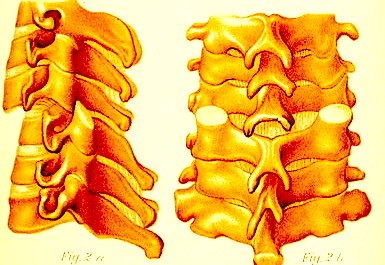
Partially Dislocated Lumbar, From Atlas and Epitome of
Traumatic,
By Heinrich Helferich (1902)
As seen previously, Paré believes in extending and replacing the partially luxated spine, although his procedures for adjusting the sacral curve are brief and not for the faint of heart. "[Y]ou must thrust your finger in by the Fundament [anus], even to the place affected... then must you strongly raise up the bone, and with your other hand at the same time join it rightly on the outside with the neighbouring parts"6.
He recommends bandaging it like the back, although given the location, this is one place that more detail would have been helpful. Paré says it takes twenty days to heal and finishes with an interesting comment on facilitating the healing. "During all which time the Patient must not go to stool, unless sitting upon a hollow seat, lest the bone, as yet scarce well recovered, should fall again out of its place."7
1 John Atkins, The Navy Surgeon, 1742, p. 100; 2 Ambroise Paré, The Workes of that Famous Chirurgion Ambrose Parey, 1649, p. 388; 3 Atkins, p. 100; 4,5 Atkins, p. 101; 6,7 Paré, p. 388
Specific Dislocation/Luxation Cure: Vertebrae - Collar Bone
Richard Wiseman points out that the collar bone (the clavicle) can be dislocated at either end, "one at the Sternon [or sternum], and that only outwardly

Dislocations of the Clavicles, From A treatise on dislocations and on
fractures of
the joints, By Astley Cooper (1824)
[seen at B in the image], where it riseth from the Breast, and lieth like a Lump; the broad end near the Acromium [Acromion - protruding bony process on the shoulder blade] is also subject to a twofold Luxation, viz. upward, and forward [A]; being defended from all other Distortions by its neighbouring Bones."1 Ambroise Paré says that "both these kinds of dislocations are very rare, by reason of the strait [tight] and firm connexion which the collar bone hath with the foresaid parts; but chiefly where it is joined to the sternum, it can scarce be deprest"2. Wiseman agrees, adding "but being luxated, it is most difficultly retained after Restitution, by reason of the smoothness of its heads, and the little hold they have upon the Acronium and Sternon"3. Paré warns that "if this bone, when it is dislocated, be not set, the Patient shall be lame during his life, so that he shall not be able, neither to put his hand to his head nor mouth."4
Sea surgeon John Atkins says that the collar bones are only "through great Violence displaced, with, or without the Dislocation of the Os Humerus [upper arm bone]."5 Wiseman says that it is dislocated "by a Fall and pitching upon the Shoulder. It is discerned by the Prominence it maketh."6 Atkins agrees, noting that it can be noticed by the bone being "a little upward and forward, with [the patient having] Pain and Difficulty in moving the Arm."7
Reducing and Caring For a Dislocated Clavicle
Atkins reports that it is easy to replace, although for quick repair of a collar bone Paré's method is the simplest: "generally the collar bone is put into its place by moving or extending the arm."8 Wiseman's recommendation for reduction is basically the same. Atkins' method is to place "some convex Body between the Shoulders, (as your Knee) and pulling both back at the same time, you bring them to answer."9 Sea surgeon John Moyle offers

Surgeon Adjusting Arm, From Medicinesche Chirurgische
und
Anatomische Schrifften (1692)
similar, albeit slightly more complex, method requiring "your Mate [assistant] to take hold of him by the Shoulder, and another Assistant to hold him by the Neck; and let both make extension inclining backward, and you with your hands place the bone aright"10. Not to be outdone, Paré suggests an alternative method for reducing a dislocated collar bone, slightly more complex than Moyle's, although involving fewer people. "[I]f need require, the Patient shall be laid upon the ground with his face upwards, a Tray with the bottome upwards, a hard stuffed cushion, or the like thing being put under his shoulders; for thus ...you may restore it; for thus the prominency may be forced into its cavity."11
Wiseman says that the hard part of the operation is actually securing the clavicle once it has been properly restored, because "it will scarce hold right till you make your Applications [dressings]."12
For medicines, Wiseman recommends the use of plasters, although he doesn't specify them. Atkins advises using defensive plasters, which are formulated to heal the body's tissues and protect them from the air, but he is not specific either. A general recipe for a defensive plasters in use at this time can be found here. Moyle suggests using 'Emplastrum defensive Minor', a type of defensive plaster specifically for luxations which is made according to his own recipe.
Paré says that it is "requisite to bind it up and lay boulsters [compresses] thereon"13. All four surgeons agree with this with Wiseman giving the most complete description of the dressing to be used. He says,
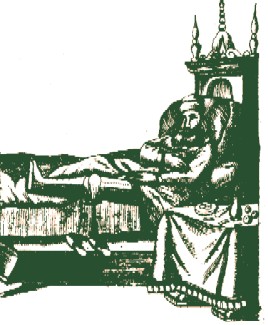
Arm Secured and Patient Resting, From l'Arcenal
de Chirurgery, By Johannes Scultetus, p. 59 (1665)
Compresses, and Bandage Splints are also of use, whether they be of Pastboard, the Scabbard of a Sword, or Tin. The Bandage ought to be a Rowler with two heads to come over the Shoulders and under the Arm-pit, making so many Circumvolutions as may retain the Dressings close. This being well made, his Arm must be kept up with a Napkin or Towel, and his hand placed upon his Breast.14
Atkins explains that last concept, telling his reader that "pinning down the Arm from Motion... [is part of] the proper Means of Recovery."15
Post-operative care according to Moyle includes bloodletting - a humoral cure-all - and the administration of a Traumatic Drink or Bolus designed to encourage healing.16 Paré orders the patient to give the wounded part rest. Atkins similarly says it must be placed in a 'steady position' if the bones are to be retained in their proper place. Wiseman says, "If all be well, you ought not to loosen the Bandage till you judge it united, which may be guessed at by the ease and use of that Arm."17
1 Richard Wiseman, Severall Chirurgicall Treatises, 2nd ed., 1686, p. 484; 2 Ambroise Paré, The Workes of that Famous Chirurgion Ambrose Parey, 1649, p. 384; 3 Wiseman, p. 484; 4 Paré, p. 385; 5 John Atkins, The Navy Surgeon, 1742, p. 106; 6 Wiseman, p. 484; 7 Atkins, p. 106; 8 Paré, p. 385; 9 Atkins, p. 106; 10 John Moyle, Chirugius Marinus: Or, The Sea Chirurgeon, 1693, p. 105; 11 Paré, p. 385; 12 Wiseman, p. 484; 13 Paré, p. 385; 14 Wiseman, p. 484; 15 Atkins, p. 106; 16 Moyle, p. 105; 17 Wiseman, p. 484

